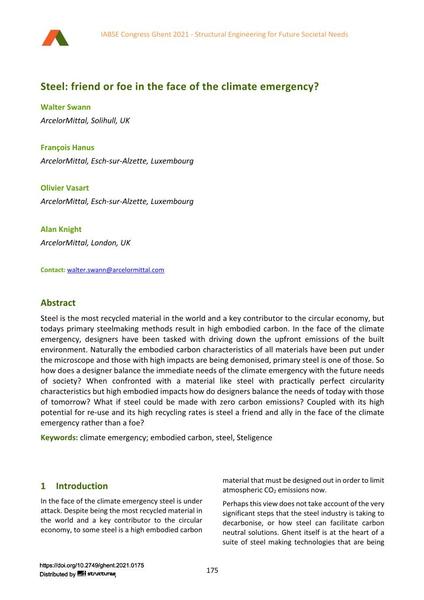Steel: friend or foe in the face of the climate emergency?

|
|
|||||||||||
Bibliografische Angaben
| Autor(en): |
Walter Swann
(ArcelorMittal, Solihull, UK)
Francois Hanus (ArcelorMittal, Esch-sur-Alzette, Luxembourg) Olivier Vasart (ArcelorMittal, Esch-sur-Alzette, Luxembourg) Alan Knight (ArcelorMittal, London, UK) |
||||
|---|---|---|---|---|---|
| Medium: | Tagungsbeitrag | ||||
| Sprache(n): | Englisch | ||||
| Tagung: | IABSE Congress: Structural Engineering for Future Societal Needs, Ghent, Belgium, 22-24 September 2021 | ||||
| Veröffentlicht in: | IABSE Congress Ghent 2021 | ||||
|
|||||
| Seite(n): | 175-182 | ||||
| Anzahl der Seiten (im PDF): | 8 | ||||
| Jahr: | 2021 | ||||
| DOI: | 10.2749/ghent.2021.0175 | ||||
| Abstrakt: |
Steel is the most recycled material in the world and a key contributor to the circular economy, but todays primary steelmaking methods result in high embodied carbon. In the face of the climate emergency, designers have been tasked with driving down the upfront emissions of the built environment. Naturally the embodied carbon characteristics of all materials have been put under the microscope and those with high impacts are being demonised, primary steel is one of those. So how does a designer balance the immediate needs of the climate emergency with the future needs of society? When confronted with a material like steel with practically perfect circularity characteristics but high embodied impacts how do designers balance the needs of today with those of tomorrow? What if steel could be made with zero carbon emissions? Coupled with its high potential for re-use and its high recycling rates is steel a friend and ally in the face of the climate emergency rather than a foe? |
||||
| Stichwörter: |
Stahl
|
||||
| Copyright: | © 2021 International Association for Bridge and Structural Engineering (IABSE) | ||||
| Lizenz: | Die Urheberrechte (Copyright) für dieses Werk sind rechtlich geschützt. Es darf nicht ohne die Zustimmung des Autors/der Autorin oder Rechteinhabers/-in weiter benutzt werden. |
||||
